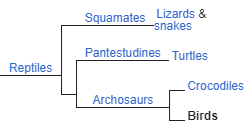We had known that birds are descended from dinosaurs well before the general public and the majority of paleontologists starting saying "birds are dinosaurs". So simply saying that "we discovered that birds are descended from dinosaurs" is not sufficient to answering your question.
Traditional taxonomy allows for paraphyletic groups, meaning that not all of the descendants of the most recent common ancestor of the group are required to be in that group. So in this case, even though it was known that birds are descended from dinosaurs, they continued to be considered two separate groups, with dinosaurs being a paraphyletic group. Birds were known first, dinosaurs were later discovered and were considered a distinct group, then the link between the the two groups was discovered, but how they were grouped did not immediately change. That birds were not considered to be dinosaurs was a rather arbitrary effect based on how they were discovered and not on any scientific basis.
One book on dinosaurs from 1997 wrote:
So why the change? There is a trend in science to prefer cladistic classification, which requires every group to be a clade, meaning that all descendants of the most recent common ancestor of a group are in the group. This effectively means that paraphyletic grouping is being abandoned. So with cladistic taxonomy birds are dinosaurs.
There are other traditionally paraphyletic groups that are still in the process of changing. For example traditionally monkeys were a paraphyletic group, but any clade that includes all monkeys necessarily includes the apes, so in cladistics apes are monkeys. Though, you will still hear many people say 'apes are not monkeys'. Fish was also a paraphyletic group, which included all vertebrates except tetrapods, but of course in cladistics, tetrapods are fish.
